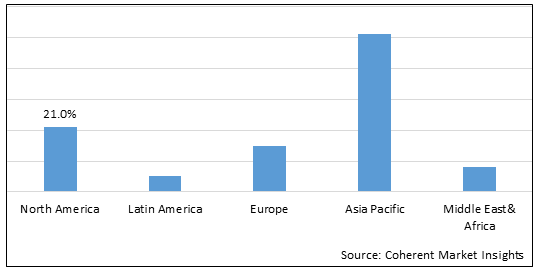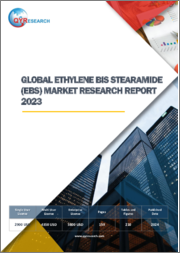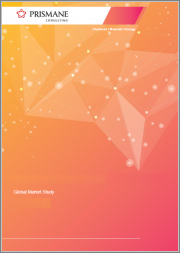
|
시장보고서
상품코드
1449650
지방 아미드 시장 : 제품 유형별, 형태별, 지역별Fatty Amides Market, By Product Type (Erucamide, Oleamide, Stearamide, Behenamide), By Form (Powder, Beads, Micro-beads, Pastilles), By Geography (North America, Latin America, Europe, Asia Pacific, Middle East & Africa) |
||||||
지방 아미드 시장 규모는 2024년에 4억 2,820만 달러로 추정되고, 2024년부터 2031년까지 연평균 복합 성장률(CAGR) 4.1%로 성장할 전망이며, 2031년에는 5억 6,810만 달러에 달할 것으로 예측됩니다.
| 보고 범위 | 보고서 세부정보 | ||
|---|---|---|---|
| 기준년 | 2023년 | 2023년 및 2024년 시장 규모 | 4억 2,820만 달러 |
| 실적 데이터 | 2019-2023년 | 예측 기간 | 2024-2031년 |
| 예측기간 2023년 및 2024년-2030년 및 2031년 CAGR : | 4.10% | 2030년 및 2031년 가치 예측 | 5억 6,810만 달러 |

세계의 지방 아미드 시장은 플라스틱, 고무, 페인트 등 다양한 최종 이용 산업에서의 용도 확대로 최근 몇 년간 현저한 성장을 이루고 있습니다. 지방 아미드는 주로 이러한 산업에서 윤활제, 유동 촉진제, 블루밍 방지제로 사용됩니다. 지방 아미드는 우수한 열 안정성, 내약품성, 넓은 액성 범위와 같은 우수한 특성을 갖추고 있습니다. 게다가, 재생가능한 동식물 유래의 지방 아미드는 석유 유래 제품에 대한 의존도를 낮추는데 도움이 되어 시장 성장을 뒷받침하고 있습니다. 그러나 원료 가격 변동은 여전히 중요한 과제입니다. 그러나 바이오 화학물질의 지속가능성과 장점에 대한 의식이 높아짐에 따라 지방아미드 제조업체의 비즈니스 기회가 확대되고 있습니다. 지방 아미드는 종종 지방산 아미드라고 불리며, OH 기가 NH2(아민) 기로 치환된 유기 지방산의 유도체입니다. 제품 유형에 따라 지방 아미드는 엘카미드, 올레인 아미드, 스테아라미드, 베헤나미드로 구별됩니다. 지방 아미드를 포함한 제품은 비드, 분말, 일부 경우에는 파스틸 형태로 판매됩니다.
시장 역학 :
세계의 지방 아미드 시장의 성장을 견인하고 있는 것은 플라스틱 및 고무 산업의 성장에 의한 수요 증가, 바이오 화학물질 보급 등의 요인입니다. 지방 아미드는 플라스틱과 고무의 배합에서 윤활제, 이형제, 안티 블로킹제로서 주요 용도를 발견하고 있습니다. 또한 고성능 제품에 대한 요구가 증가함에 따라 지방 아미드의 소비를 뒷받침하고 있습니다. 그러나 팜유, 야자유, 토르유 등 원료의 가격 변동이나 불안정한 공급이 큰 과제가 되고 있습니다. 게다가 석유화학 기반 제품의 배출에 대한 엄격한 환경 규제는 시장 성장을 억제하고 있습니다. 한편, 지속가능성 및 바이오 화학물질에 대한 선호도의 변화는 큰 기회를 가져옵니다. 대기업은 새로운 응용 분야와 친환경 생산 기술을 개발하기 위해 연구개발에 투자하고 있습니다.
본 조사의 주요 특징
- 본 보고서에서는 지방 아미드 시장을 상세하게 분석하여 2023년을 기준년으로 한 예측기간(2024-2031년) 시장 규모 및 복합연간 성장률(CAGR%)을 제공합니다.
- 또한 다양한 부문에 걸친 잠재적인 수익 성장 기회를 밝히고, 이 시장에 대한 매력적인 투자 제안의 행렬에 대해 설명합니다.
- 또한 시장 성장 촉진요인, 억제요인, 기회, 신제품 출시 및 승인, 시장 동향, 지역별 전망, 주요 기업이 채용하는 경쟁 전략 등에 관한 중요한 인사이트도 제공합니다.
- 기업 하이라이트, 제품 포트폴리오, 주요 하이라이트, 재무 실적, 전략 등의 매개변수에 따라 지방 아미드 시장의 주요 기업을 프로파일링합니다.
- 이 보고서의 인사이트를 통해 마케팅 담당자와 기업 경영진은 향후 제품 출시, 유형 업그레이드, 시장 확대, 마케팅 전술에 대한 정보를 바탕으로 의사 결정을 내릴 수 있습니다.
- 지방 아미드 시장 보고서는 투자자, 공급업체, 제품 제조업체, 유통업체, 신규 참가자, 재무 분석가 등이 업계의 다양한 이해 관계자를 지원합니다.
목차
제1장 조사의 목적 및 전제조건
- 조사 목적
- 전제조건
- 약어
제2장 시장 전망
- 보고서 설명
- 시장 정의 및 범위
- 주요 요약
- Coherent Opportunity Map(COM)
제3장 시장 역학, 규제 및 동향 분석
- 시장 역학
- 퍼스널케어 업계로부터 수요 증가
- 대체품의 이용가능성
- 틈새 양식에 대한 지방산 아미드의 혁신
- 주요 하이라이트
- 규제 시나리오
- 최근 동향
- 제품 출시 및 승인
- PEST 분석
- Porter's Five Forces 분석
- 합병, 인수 및 협업
제4장 지방 아미드 시장-코로나 바이러스(COVID-19) 팬데믹의 영향
- 신형 코로나 바이러스 감염증(COVID-19)의 역학
- 공급측 및 수요측 분석
- 경제적 영향
제5장 지방 아미드 시장 : 제품 유형별(2019-2031년)
- 엘카미드
- 스테아라미드
- 베헤나미드
- 올레아미드
제6장 지방 아미드 시장 : 형태별(2019-2031년)
- 파우더 및 비즈
- 마이크로 비드
- 트로이
제7장 지방 아미드 시장 : 지역별(2019-2031년)
- 시장 점유율 분석 : 지역별(2024년 및 2031년)(%)
- 전년대비 성장 분석 : 지역별(2020-2031년)
- 각국의 동향
- 북미
- 미국
- 캐나다
- 유럽
- 독일
- 영국
- 스페인
- 프랑스
- 이탈리아
- 러시아
- 기타 유럽
- 아시아태평양
- 중국
- 인도
- 일본
- 호주
- 한국
- ASEAN
- 기타 아시아태평양
- 라틴아메리카
- 브라질
- 아르헨티나
- 멕시코
- 기타 라틴아메리카
- 중동 및 아프리카
- GCC 국가
- 이스라엘
- 기타 중동
- 남아프리카
- 중앙 아프리카
- 북아프리카
제8장 경쟁 구도
- 기업 프로파일
- Lonza
- Novartis International AG
- BASF AG
- SEQENS
- Carbogen Amcis AG
- Eli Lilly and Company
- Teva Pharmaceutical Industries Ltd
- Bristol-Myers Squibb
- Pfizer Inc.
- Roche Diagnostics
- Boehringer Ingelheim
- Merck &Co
- Bayer AG
- Ajinomoto Bio-Pharma Services
- Cambrex Corporation
- Minakem
- Sanofi Aventis
제9장 섹션
- 참고 문헌
- 조사 방법
- 출판사에 대해
The fatty amides Market size is valued at US$ 428.2 Mn in 2024 and is expected to reach US$ 568.1 Mn by 2031, growing at a compound annual growth rate (CAGR) of 4.1% from 2024 to 2031.
| Report Coverage | Report Details | ||
|---|---|---|---|
| Base Year: | 2023 | Market Size in 2023/2024: | US$ 428.2 Mn |
| Historical Data for: | 2019 to 2023 | Forecast Period: | 2024 - 2031 |
| Forecast Period 2023/2024 to 2030/2031 CAGR: | 4.10% | 2030/2031 Value Projection: | US$ 568.1 Mn |

The global fatty amides market has been witnessing significant growth in recent years driven by growing applications in various end-use industries such as plastics, rubber, coatings, and others. Fatty amides are mainly used as lubricants, flow promoters, and anti-blooming agents in these industries. They offer excellent properties such as outstanding thermal stability, chemical resistance, and wide liquid range. Additionally, fatty amides derived from renewable plant and animal sources help reduce dependency on petroleum-based products, thereby boosting the market growth. However, fluctuations in raw material prices remain a key challenge. But growing awareness about sustainability and benefits of bio-based chemicals is expanding opportunities for fatty amides manufacturers. Fatty amides, often termed fatty acid amides, are derivatives of organic fatty acids where an OH group is replaced by an NH2 (amine) group. Depending on the type of product, fatty amides are differentiated as erucamides, oleamides, stearamides, and behenamides. Products containing fatty amides are available in beads, powders, and sometimes also the pastilles form.
Market Dynamics:
The growth of the global fatty amides market is driven by factors such as increasing the demand from the thriving plastics and rubber industries and widespread adoption of bio-based chemicals. Fatty amides find major applications as lubricants, release agents, and anti-blocking agents in plastics and rubber formulations. Additionally, the growing need for high-performance products is propelling the consumption of fatty amides. However, fluctuations in prices and unreliable supply of raw materials such as palm oil, coconut oil, and tall oil pose a major challenge. Furthermore, strict environmental regulations regarding emissions from petrochemical-based products restrain the market growth. Meanwhile, shifting preference toward sustainability and bio-based chemicals presents significant opportunities. Leading players are investing in R&D to develop novel application areas and green production technologies.
Key Features of the Study:
- This report provides an in-depth analysis of the fatty amides market, and provides market size (US$ Million) and compound annual growth rate (CAGR %) for the forecast period (2024-2031), considering 2023 as the base year
- It elucidates potential revenue growth opportunities across different segments and explains attractive investment proposition matrices for this market
- This study also provides key insights about market drivers, restraints, opportunities, new product launches or approvals, market trends, regional outlook, and competitive strategies adopted by key players
- It profiles key players in the fatty amides market based on the following parameters - company highlights, products portfolio, key highlights, financial performance, and strategies
- Key companies covered as a part of this study include Haihang Industries Co. Ltd., Croda International Plc., PMC Biogenix Inc., Fine Organic Industries Pvt. Ltd., Nippon Fine Chemicals Co., Ltd., Kao Corporation, Italmatch Chemicals S.p.A., Sichuan Tianyu Oleochemical Co., Ltd., and Nippon Kasei Chemical Co., Ltd.
- Insights from this report would allow marketers and the management authorities of the companies to make informed decisions regarding their future product launches, type up-gradation, market expansion, and marketing tactics
- The fatty amides market report caters to various stakeholders in this industry including investors, suppliers, product manufacturers, distributors, new entrants, and financial analysts
Detailed Segmentation:
- Fatty Amides Market, By Product Type
- Erucamides
- Oleamides
- Stearamides
- Behenamides
- Fatty Amides Market, By Form
- Powder, Beads
- Micro-beads
- Pastilles
- Fatty Amides Market, By Region
- North America
- Latin America
- Europe
- Asia Pacific
- Middle East
- Africa
- Top Companies in the Fatty Amides Market:
- Haihang Industries Co. Ltd.
- Croda International Plc.
- PMC Biogenix Inc.
- Fine Organic Industries Pvt. Ltd.
- Nippon Fine Chemicals Co., Ltd.
- Kao Corporation
- Italmatch Chemicals S.p.A.
- Sichuan Tianyu Oleochemical Co., Ltd.
- Nippon Kasei Chemical Co., Ltd
Table of Contents
1. Research Objectives and Assumptions
- Research Objectives
- Assumptions
- Abbreviations
2. Market Purview
- Report Description
- Market Definition and Scope
- Executive Summary
- Fatty Amides Market, By Product Type
- Fatty Amides Market, By Form
- Fatty Amides Market, By Region
- Coherent Opportunity Map (COM)
3. Market Dynamics, Regulations, and Trends Analysis
- Market Dynamics
- Drivers
- Increasing demand from the personal care industry
- Restraints
- Availability of substitutes
- Opportunities
- Innovation of fatty amides for niche Forms
- Key Highlights
- Regulatory Scenario
- Recent Trends
- Product Launches/Approvals
- PEST Analysis
- PORTER's Analysis
- Mergers, Acquisitions, and Collaborations
4. Fatty Amides Market- Impact of Coronavirus (COVID-19) Pandemic
- COVID-19 Epidemiology
- Supply Side and Demand Side Analysis
- Economic Impact
5. Fatty Amides Market, By Product Type, 2019-2031, (US$ Mn)
- Introduction
- Market Share Analysis, 2024 and 2031 (%)
- Y-o-Y Growth Analysis, 2020 - 2031
- Segment Trends
- Erucamide
- Introduction
- Market Size and Forecast, and Y-o-Y Growth, 2019-2031,(US$ Mn)
- Stearamide
- Introduction
- Market Size and Forecast, and Y-o-Y Growth, 2019-2031,(US$ Mn)
- Behenamide
- Introduction
- Market Size and Forecast, and Y-o-Y Growth, 2019-2031,(US$ Mn)
- Oleamide
- Introduction
- Market Size and Forecast, and Y-o-Y Growth, 2019-2031,(US$ Mn)
6. Fatty Amides Market, By Form , 2019-2031, (US$ Mn)
- Introduction
- Market Share Analysis, 2024 and 2031 (%)
- Y-o-Y Growth Analysis, 2020 - 2031
- Segment Trends
- Powder, Beads
- Introduction
- Market Size and Forecast, and Y-o-Y Growth, 2019-2031,(US$ Mn)
- Micro-beads
- Introduction
- Market Size and Forecast, and Y-o-Y Growth, 2019-2031,(US$ Mn)
- Pastilles
- Introduction
- Market Size and Forecast, and Y-o-Y Growth, 2019-2031,(US$ Mn)
7. Fatty Amides Market , By Region, 2019-2031, (US$ Mn)
- Introduction
- Market Share Analysis, By Region, 2024 and 2031 (%)
- Y-o-Y Growth Analysis, For Region, 2020 - 2031
- Country Trends
- North America
- Introduction
- Market Size and Forecast, and Y-o-Y Growth, By Product Type , 2019-2031,(US$ Mn)
- Market Size and Forecast, and Y-o-Y Growth, By Form, 2019-2031,(US$ Mn)
- Market Size and Forecast, and Y-o-Y Growth, By Country, 2019-2031,(US$ Mn)
- U.S.
- Canada
- Europe
- Introduction
- Market Size and Forecast, and Y-o-Y Growth, By Product Type , 2019-2031,(US$ Mn)
- Market Size and Forecast, and Y-o-Y Growth, By Form, 2019-2031,(US$ Mn)
- Market Size and Forecast, and Y-o-Y Growth, By Country, 2019-2031,(US$ Mn)
- Germany
- U.K.
- Spain
- France
- Italy
- Russia
- Rest of Europe
- Asia Pacific
- Introduction
- Market Size and Forecast, and Y-o-Y Growth, By Product Type , 2019-2031,(US$ Mn)
- Market Size and Forecast, and Y-o-Y Growth, By Form, 2019-2031,(US$ Mn)
- Market Size and Forecast, and Y-o-Y Growth, By Country, 2019-2031,(US$ Mn)
- China
- India
- Japan
- Australia
- South Korea
- ASEAN
- Rest of Asia Pacific
- Latin America
- Introduction
- Market Size and Forecast, and Y-o-Y Growth, By Product Type , 2019-2031,(US$ Mn)
- Market Size and Forecast, and Y-o-Y Growth, By Form, 2019-2031,(US$ Mn)
- Market Size and Forecast, and Y-o-Y Growth, By Country, 2019-2031,(US$ Mn)
- Brazil
- Argentina
- Mexico
- Rest of Latin America
- Middle East & Africa
- Introduction
- Market Size and Forecast, and Y-o-Y Growth, By Product Type , 2019-2031,(US$ Mn)
- Market Size and Forecast, and Y-o-Y Growth, By Form, 2019-2031,(US$ Mn)
- Market Size and Forecast, and Y-o-Y Growth, By Country, 2019-2031,(US$ Mn)
- GCC Countries
- Israel
- Rest of Middle East
- South Africa
- Central Africa
- North Africa
8. Competitive Landscape
- Company Profile
- Lonza
- Company Highlights
- Product Portfolio
- Key Developments
- Financial Performance
- Strategies
- Novartis International AG
- Company Highlights
- Product Portfolio
- Key Highlights
- Financial Performance
- Strategies
- BASF AG
- Company Highlights
- Product Portfolio
- Key Highlights
- Financial Performance
- Strategies
- SEQENS
- Company Highlights
- Product Portfolio
- Key Highlights
- Financial Performance
- Strategies
- Carbogen Amcis AG
- Company Highlights
- Product Portfolio
- Key Highlights
- Financial Performance
- Strategies
- Eli Lilly and Company
- Company Highlights
- Product Portfolio
- Key Highlights
- Financial Performance
- Strategies
- Teva Pharmaceutical Industries Ltd
- Company Highlights
- Product Portfolio
- Key Highlights
- Financial Performance
- Strategies
- Bristol-Myers Squibb
- Company Highlights
- Product Portfolio
- Key Developments
- Financial Performance
- Strategies
- Pfizer Inc.
- Company Highlights
- Product Portfolio
- Key Highlights
- Financial Performance
- Strategies
- Roche Diagnostics
- Company Highlights
- Product Portfolio
- Key Highlights
- Financial Performance
- Strategies
- Boehringer Ingelheim
- Company Highlights
- Product Portfolio
- Key Highlights
- Financial Performance
- Strategies
- Merck & Co
- Company Highlights
- Product Portfolio
- Key Highlights
- Financial Performance
- Strategies
- Bayer AG
- Company Highlights
- Product Portfolio
- Key Highlights
- Financial Performance
- Strategies
- Ajinomoto Bio-Pharma Services
- Company Highlights
- Product Portfolio
- Key Highlights
- Financial Performance
- Strategies
- Cambrex Corporation
- Company Highlights
- Product Portfolio
- Key Highlights
- Financial Performance
- Strategies
- Minakem
- Company Highlights
- Product Portfolio
- Key Highlights
- Financial Performance
- Strategies
- Sanofi Aventis
- Company Highlights
- Product Portfolio
- Key Highlights
- Financial Performance
- Strategies
- Analyst Views
9. Section
- References
- Research Methodology
- About us



















